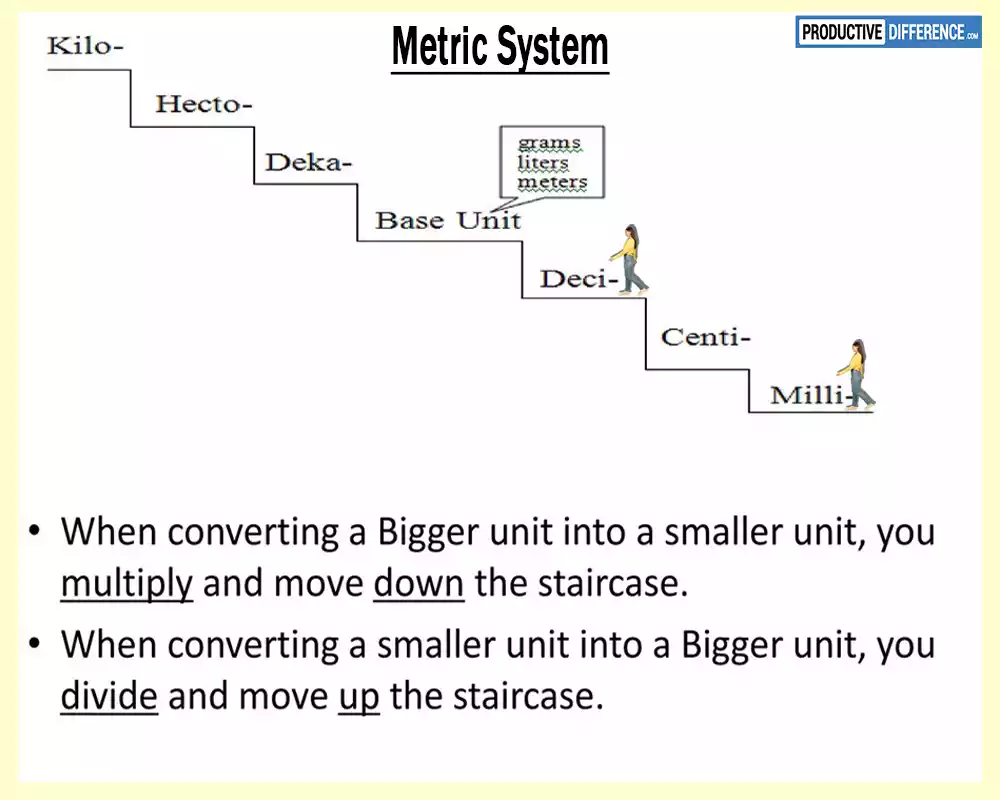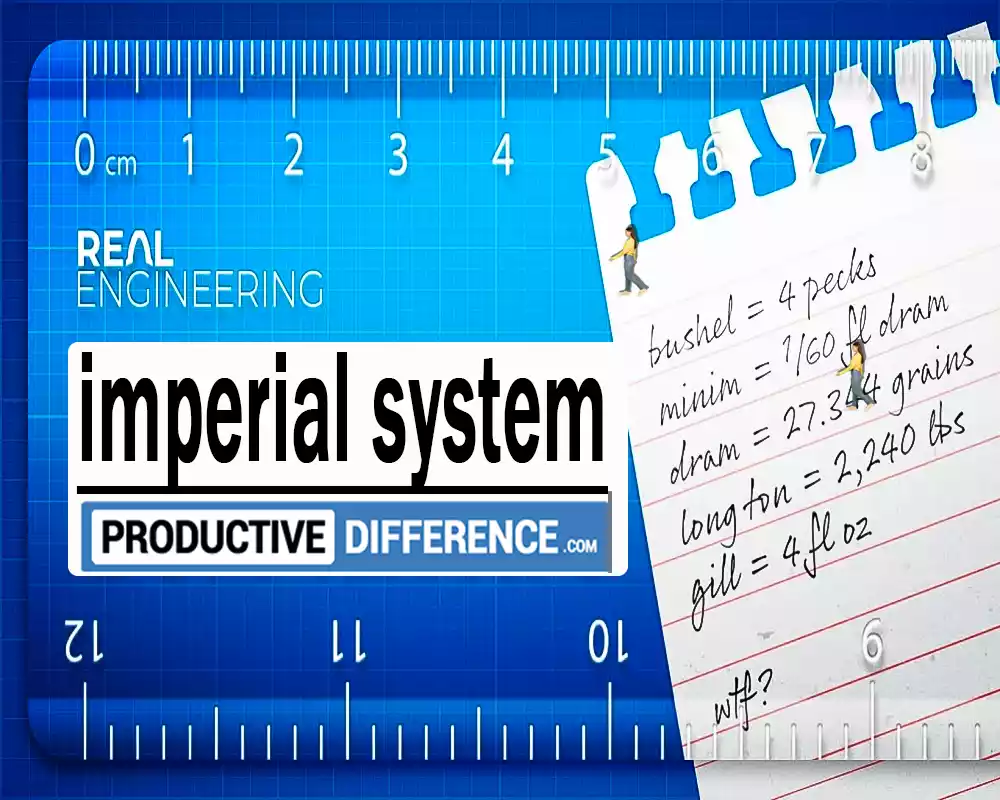The Metric and Imperial systems are two different systems of measurement used around the world. The Metric system, also known as the International System of Units (SI), is based on multiples of ten and includes units like the meter for length, the gram for weight, and the liter for volume. It’s widely used in science and most countries globally.
On the other hand, the Imperial system, which originated in the British Empire, uses units like the foot for length, the pound for weight, and the gallon for volume. It is still used in a few countries, including the United States for everyday measurements. The coexistence of these two systems in different parts of the world reflects varied historical and cultural practices in measurement.
What is the Metric System?
The Metric system also referred to as the International System of Units (SI), is an international decimal-based measurement system widely adopted today. This decimal-based system offers a consistent and standardized method of gauging various quantities such as length, mass, volume temperature, and more. Established by France during the late 18th century has since become one of the world’s primary standards of measurement.
The Metric system is based on a set of base units and prefixes that allow for easy scaling and conversion between different units. The fundamental units in the Metric system include the meter for length, the kilogram for mass, the second for time, the ampere for electric current, the kelvin for temperature, the mole for the amount of substance, and the candela for luminous intensity.

One of the key features of the Metric system is its decimal nature. Each unit is based on powers of ten, which means that conversion between units is simple. For example, converting from kilometers to meters involves multiplying the value by 1,000, as there are 1,000 meters in a kilometer.
The Metric system offers several advantages over other systems of measurement. Its standardized units and prefixes make it easy to understand and use, both in scientific and everyday contexts. The decimal nature of the system allows for precise and accurate measurements, reducing the likelihood of errors. Additionally, the Metric system promotes international communication and trade by providing a universal language for measurement.
In everyday life, the Metric system is used in various fields such as science, engineering, medicine, education, and industry. It is utilized for measuring distances, weights, volumes, temperatures, and many other quantities. For example, when purchasing groceries, you might find items labeled with metric units such as grams, kilograms, liters, or milliliters. In scientific experiments, measurements are often recorded using metric units to ensure consistency and compatibility across different research studies.
The Metric system is a versatile and widely accepted system of measurement that simplifies the process of quantifying and comparing physical quantities. Its logical and decimal-based structure facilitates easy conversions and promotes international standardization. Understanding and using the Metric system is essential for effective communication, scientific endeavors, and global collaboration.
What is the Origin of the Metric System?
The metric can be traced back to France during the late 18th century during their Revolution, beginning in 1789, which resulted in significant social and political changes that included an imperative for standardizing measurement across regions and professions at that time. Prior to 1789, France had an incoherent, complex, fragmented system of measurements across regions and professions using different units and standards that led to confusion regarding measurements that existed within different professions compared with current standards used globally today.
To address this issue, the French Academy of Sciences appointed a committee in 1790, known as the “Commission des Poids et Mesures,” to develop a uniform system of measurement. This committee was led by prominent French scientists and mathematicians, including Jean-Charles de Borda, Joseph-Louis Lagrange, and Pierre-Simon Laplace.
The committee’s objective was to create a system that was logical, universal, and based on natural phenomena. They sought to establish a system that could be easily understood and used by all, regardless of their profession or geographic location. The fundamental idea behind the new system was to base it on the decimal system, where units would be related to powers of ten.
In 1791, the French National Assembly officially adopted the new system of measurement, which came to be known as the “Metric system” (système métrique). The name “Metric” was derived from the Greek word “metron,” meaning measure. The Metric system introduced new units of measurement, such as the meter for length and the kilogram for mass, which were defined based on natural phenomena and physical constants.
The meter was initially defined as one ten-millionth of the distance from the North Pole to the equator, passing through Paris. However, later advancements in science led to a more precise definition based on the speed of light. The kilogram was defined as the mass of a specific platinum-iridium cylinder, known as the International Prototype of the Kilogram.
The Metric system gained popularity and recognition beyond France due to its logical and consistent structure. It spread to other countries through international treaties and diplomatic efforts. Over time, the system evolved, and additional units were introduced to cover various aspects of measurement.
In 1960, the Metric system underwent a significant revision and became known as the International System of Units (SI). The SI system further refined and expanded the Metric system, incorporating advancements in science and technology.
Today, the Metric system, in its SI form, is the most widely used system of measurement worldwide. It provides a universal language for measurement, promoting consistency, accuracy, and ease of communication in various fields, including science, engineering, commerce, and everyday life.
Common Metric Measurements
The list is short because conversions between the metric and imperial systems are simple!
- One kilogram is 1000 grams.
- One gram is 1000 milligrams
- One liter is 1000 milliliters
- One kilometer is 1000 meters.
What is the Imperial System?
The Imperial system is a system of measurement that originated in ancient Rome and later spread throughout the British Empire. Imperial measurements are most prevalently employed by several countries such as the US, Myanmar, and Liberia – though their usage has since substantially declined due to historical precedents and customary practices that differ significantly from Metric systems like that used for measuring distance and capacity.
The Imperial system includes various units of measurement for different quantities, such as length, weight, volume, and temperature. Some of the commonly used units in the Imperial system include inches, feet, yards, miles, ounces, pounds, gallons, and degrees Fahrenheit.

Units of Length
Under the Imperial system, length is measured using units such as inches, feet, yards, and miles. An inch roughly corresponds to an adult thumb while one foot approximates roughly equivalent human dimensions. A yard is equivalent to three feet, and a mile is approximately 5,280 feet or 1,760 yards.
Units of Weight
The Imperial system employs units like ounces and pounds for measuring weight. An ounce roughly corresponds with a slice of bread; one pound equals roughly that weight for small melons weighing in at about four inches thick – each of these includes 16 ounces in total.
Units of Volume
For measuring volume, the Imperial system uses units like pints, quarts, gallons, and fluid ounces. A pint is approximately the volume of a typical glass of milk, while a quart is equivalent to two pints. A gallon is approximately the volume of eight pints or four quarts. Fluid ounces are used for measuring smaller volumes, such as those in beverages.
Units of Temperature
In the Imperial system, temperature is measured in degrees Fahrenheit (°F). This scale divides the temperature range between the freezing and boiling points of water into 180 equal divisions. The freezing point of water is 32°F, while the boiling point is 212°F.
The Imperial system lacks the systematic and consistent structure of the Metric system. Conversion between different units in the Imperial system can be complex and often requires memorizing conversion factors. For example, converting from inches to feet involves dividing the value by 12, and converting from miles to yards requires multiplying the value by 1,760.
While Imperial measurements remain widely utilized across some nations, their usage has steadily been decreasing since World War I – particularly within scientific and international environments. Meanwhile, Metric systems with their ease of use, decimal structure, and global standardization have become the preferred system in most parts of the globe.
What is the Origin of the Imperial System?
The Imperial system of measurement has its origins in ancient Rome, where it was first developed and used during the Roman Empire. The system was based on various units that were commonly used at the time and eventually spread to other regions under Roman rule.
The Roman units of measurement were derived from everyday objects and body parts, making them relatable and convenient for everyday use. For example, the “foot” was originally defined as the length of an average adult foot, and the “inch” was the width of a thumb. These units were not standardized across the empire, and different regions often had their variations.
As the Roman Empire expanded so did its measurement system. The Imperial system we know today was not created until the Middle Ages, and the rise in power of the British Empire.
During the medieval period, trade and commerce became more widespread, and a standardized system of measurement was needed to facilitate transactions and ensure consistency. The units used in the Roman system were gradually refined and standardized, forming the foundation of what would later become the Imperial system.
The term “Imperial system” itself emerged during the British Empire’s colonial era when the system was used extensively throughout its territories. The British Empire’s influence, including its units of measurement, spread across the globe, particularly through colonization and trade routes.
The Imperial system underwent further developments and refinements. Acts of Parliament in the United Kingdom, such as the Weights and Measures Act of 1824, established legal standards for the system’s units, ensuring uniformity and accuracy.
The Imperial system’s units, such as inches, feet, pounds, and gallons, became deeply ingrained in the societies of countries under British influence, including the United States. These units remained in use even after many former British colonies gained independence.
The Imperial system lacks the logical and decimal structure of the Metric system, which was developed later. The Metric system’s advantages, including ease of use and global standardization, have led to its widespread adoption by most countries worldwide.
While the Imperial system is still used in a few countries today, particularly the United States, it has been largely replaced by the Metric system in many fields, such as science, international trade, and global communication.
The Key Difference between Metric and Imperial Systems
The key differences between the Metric and Imperial systems are rooted in their units, method of conversion, origin, and global usage:
- Units of Measurement:
-
- Metric: Uses units like meters, liters, and grams. It is a decimal-based system, meaning each unit is a multiple of ten (e.g., 1 meter = 100 centimeters, 1 liter = 1000 milliliters).
- Imperial: Uses units such as feet, gallons, and pounds. Its units do not have a uniform conversion factor, making the system more complex (e.g., 1 foot = 12 inches, 1 gallon = 128 ounces).
- Method of Conversion:
-
- Metric: Conversions within the Metric system are straightforward due to its base-10 structure. Multiplying or dividing by 10, 100, or 1000 is common for conversions.
- Imperial: Requires memorization of different conversion factors as there is no standard base. Conversions often involve fractions and are less intuitive.
- Origin and Development:
-
- Metric: Developed during the French Revolution to standardize measurements and has been adopted globally. It’s continuously updated and regulated by the International System of Units (SI).
- Imperial: Originated from the various measurement systems used in the British Empire. It has evolved over time, but its basic structure remains unchanged.
- Global Usage:
-
- Metric: The dominant system worldwide, used in almost all countries and in international commerce, science, and engineering.
- Imperial: Primarily used in the United States and to a lesser extent in the United Kingdom and a few other countries.
- Application:
-
- Metric: Preferred in scientific and technical fields due to its precision and ease of conversion.
- Imperial: Often used in everyday life in countries where it’s prevalent, such as in cooking, construction, and navigation in the USA.
Comparison Table between Metric and Imperial
Here’s a comparison table highlighting some of the basic units of measurement in both the Metric and Imperial systems:
| Aspect | Metric System | Imperial System |
| Length | ||
| Small Units | Millimeters (mm), Centimeters (cm) | Inches (in) |
| Medium Units | Meters (m) | Feet (ft), Yards (yd) |
| Large Units | Kilometers (km) | Miles (mi) |
| Mass/Weight | ||
| Small Units | Grams (g) | Ounces (oz) |
| Medium Units | Kilograms (kg) | Pounds (lb) |
| Large Units | Metric Tons (t) | Tons |
| Volume | ||
| Small Units | Milliliters (ml) | Fluid Ounces (fl oz) |
| Medium Units | Liters (l) | Pints (pt), Quarts (qt) |
| Large Units | Cubic Meters (m³) | Gallons (gal) |
| Area | Square Meters (m²), Hectares (ha) | Square Feet (sq ft), Acres |
| Temperature | Celsius (°C) | Fahrenheit (°F) |
This table provides a basic comparison and does not encompass all units or the complexities of conversion between the two systems. Each system has its own logic and units for various measurements.
What is the difference between the British and American imperial systems?
The United Kingdom uses old measurements because it is convenient for them. British beer is still measured in pints. However, the pint in Britain is 20 oz, compared to 16 oz in the US. They also like to measure their weights in stones. A stone being 14 lbs. As we have shown in our conversions, a Canadian or UK Imperial Gallon will be 20% larger than a US gallon.
Common Imperial Measurements
The imperial system is more difficult to convert quickly than the metric system.
Some common imperial conversions for volume measurements are:
- Three teaspoons equal one tablespoon
- 16 tablespoons per cup
- Two cups in one pint
- Two pints equal one quart
- Four cups in one quart
- 16 cups per gallon
It’s also handy to know how to convert imperial volume to imperial weight.
- 8 ounces per cup
- 16 ounces is 1 pint
- 32 ounces per quart
- 1 Gallon = 128 Ounces
How Metric and Imperial Systems Work
The Metric system and the Imperial system are two different systems of measurement, each with its unique characteristics and conventions.
Here’s a closer look at how these systems work:
Metric System:
The Metric system utilizes a decimal structure where units of measurement correspond with powers of 10. Its core units of measure include kilogram, centimeter, and millimeter.
- Meter (m): The meter is the base unit for measuring length or distance.
- Kilogram (kg): The kilogram is the base unit for measuring mass or weight.
- Second (s): The second is the base unit for measuring time.
- Kelvin (K): Kelvin is the base unit for measuring temperature in the scientific context.
- Mole (mol): The mole is the base unit for measuring the amount of substance.
- Ampere (A): The Ampere is the base unit for measuring electric current.
- Candela (cd): The Candela is the base unit for measuring luminous intensity.
These base units can be modified using prefixes to indicate larger or smaller quantities.
For example:
- Kilo-: Multiplies the base unit by 1,000 (e.g., kilometer, kilogram).
- Centi-: Divides the base unit by 100 (e.g., centimeter, centigram).
- Milli-: Divides the base unit by 1,000 (e.g., millimeter, milligram).
By using these prefixes, the Metric system allows for easy conversions between units, as they are based on powers of ten.
Imperial System
The Imperial system, in contrast, is not based on a decimal structure and relies on historical precedents and customary units. It includes various units for different quantities, such as length, weight, volume, and temperature.
Some common units in the Imperial system are:
- Inch (in): Used for measuring small lengths or distances.
- Foot (ft): Equal to 12 inches, often used for everyday measurements.
- Yard (yd): Equal to 3 feet or 36 inches, commonly used for longer measurements.
- Mile (mi): Used for measuring longer distances, especially in the context of roads and travel.
- Ounce (oz): Used for measuring small weights.
- Pound (lb): Equal to 16 ounces, commonly used for everyday weights.
- Gallon (gal): Used for measuring volume, particularly for liquids.
- Degree Fahrenheit (°F): Used for measuring temperature in non-scientific contexts.
The Imperial system lacks the systematic and consistent structure of the Metric system, making conversions between units more complex. Conversion factors and memorization of conversion formulas are often necessary.
As is important to keep in mind, while the Metric system is widely accepted worldwide and widely utilized, the Imperial system remains used mainly in certain countries such as the United States, Myanmar, and Liberia; yet even within these nations, there exists a trend toward adopting Metric system applications, especially scientific or international applications.
Understanding the workings of both systems is essential for effective communication and accurate measurement in different settings.
Advantages and Disadvantages of Metric and Imperial Systems
Both the Metric and Imperial systems of measurement have their advantages and disadvantages. Understanding these can help us assess their suitability for different applications.
Metric System
Advantages:
- Decimal Structure: The Metric system’s decimal structure makes conversions between units simple and intuitive. Shifting from one unit to another involves multiplying or dividing by powers of ten.
- Global Standardization: The Metric system, also known as the International System of Units (SI), is widely adopted and recognized globally. This standardization facilitates communication, trade, and scientific research across borders.
- Ease of Use: The Metric system’s logical and consistent structure makes it easy to learn, understand, and apply in various fields. Its units are based on fundamental properties and are well-suited for scientific calculations.
- Precision and Accuracy: The Metric system’s decimal structure allows for precise and accurate measurements due to its straightforward conversions and clear relationships between units.
Disadvantages:
- Familiarity: In regions where the Imperial system is traditionally used, there may be a learning curve and adjustment period when switching to the Metric system.
- Transition Challenges: Transitioning from the Imperial system to the Metric system can pose logistical challenges, especially in terms of updating infrastructure, educational materials, and public understanding.
- Contextual Adaptation: In certain industries or specialized fields, specific measurements or conventions may be deeply ingrained in the Imperial system, making a complete transition to the Metric system more complex.
Imperial System
Advantages:
- Familiarity and Tradition: In countries where the Imperial system is the norm, there is a level of familiarity and comfort with its units. Generations have grown up using these units, which may be deeply ingrained in daily life and cultural practices.
- Contextual Relevance: In certain industries or specialized fields, the Imperial system’s units may have specific contextual relevance and conventions that have been developed over time.
Disadvantages:
- Lack of Standardization: Unlike the Metric system, the Imperial system lacks global standardization. This lack of uniformity can create challenges in international trade, scientific collaboration, and communication.
- Complex Conversions: Converting between different units in the Imperial system can be more complex than in the Metric system. Conversion factors need to be memorized, and calculations may involve multiple steps.
- Limited Global Adoption: The Imperial system is primarily used in a few countries, which can limit its applicability and recognition in international contexts.
The Metric system’s advantages, such as its global standardization and ease of use, have led to its widespread adoption and preference in scientific research, trade, and everyday measurements. The familiarity and contextual relevance of the Imperial system in specific regions or industries should also be considered.
Final Opinion
The Metric and Imperial systems are two distinct systems of measurement, each with its strengths and limitations. The Metric system, with its decimal structure, global standardization, and ease of use, offers several advantages. It provides a logical and consistent approach to measurement, enabling easy conversions between units and promoting precision and accuracy in calculations. The Metric system’s widespread adoption and recognition on a global scale make it the preferred choice for scientific research, trade, and everyday measurements.


